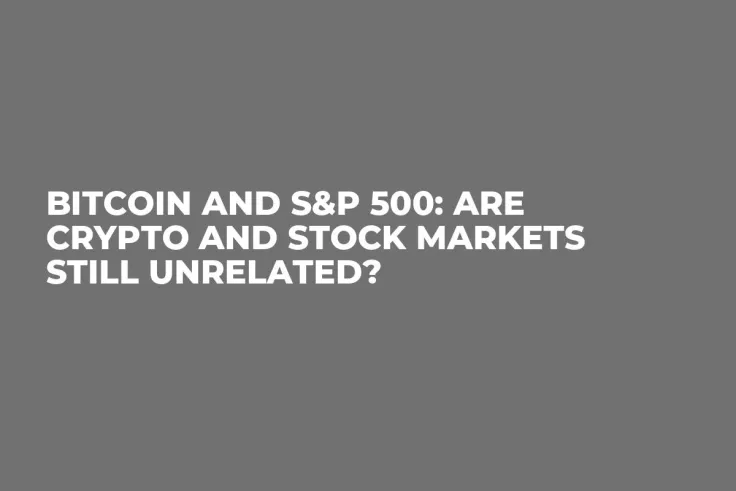
Disclaimer: The opinions expressed by our writers are their own and do not represent the views of U.Today. The financial and market information provided on U.Today is intended for informational purposes only. U.Today is not liable for any financial losses incurred while trading cryptocurrencies. Conduct your own research by contacting financial experts before making any investment decisions. We believe that all content is accurate as of the date of publication, but certain offers mentioned may no longer be available.
BTC as source of diversification
Cryptocurrencies have historically exhibited low correlations with traditional asset classes, offering a unique source of idiosyncratic risk in portfolios.
Bitcoin is known for its extreme volatility, with significant price swings like a roller-coaster ride — plunging over 64% in 2022 and then rallying 160% in 2023. This volatility can be challenging for crypto traders.
On the other hand, the S&P 500 offers more stable performance, averaging 9% to 10% annual returns and serving as a benchmark for the U.S. economy. Despite lower returns compared to Bitcoin, the S&P 500's consistency and reliability make it a favored choice for risk-averse investors seeking predictable investment outcomes.
Allocations to cryptocurrency can diversify risk and enhance returns in traditional portfolios, according to Glassnode.
For example, adding small allocations to the Coinbase Core Index (COINCORE), a market-cap weighted crypto index primarily composed of Bitcoin (70.9%) and Ether (21.9%), to a 60/40 portfolio (60% MSCI ACWI and 40% U.S. Agg) increased both absolute and risk-adjusted returns over a five-year period ending March 31, 2024.
Strong Q1 performance
During the first quarter of 2024, the total market capitalization of cryptocurrencies, including BTC, ETH, altcoins and stablecoins, rose by 63%, driven by gains in major cryptocurrencies like BTC and ETH, alongside increased stablecoin issuance.
Bitcoin (BTC) had an impressive first quarter in 2024, posting a 69% return and outperforming most traditional asset classes, according to Coinbase and Glassnode joint report.
Despite the launch of BTC ETFs, which many thought would lead to a stronger correlation with traditional finance assets, BTC displayed minimal correlation with major asset classes, using data from a recent Glassnode and Coinbase Institutional report. This suggests its potential as a valuable component for diversification within a portfolio.
BTC/S&P 500 correlation remains low
Bitcoin negatively correlated with the DXY index and gold, while its correlation with the S&P 500 was low at 0.11. This suggests that Bitcoin’s price movements are largely independent of traditional markets.
However, at the start of Q2, BTC is down 15% from its highs, coinciding with the DXY index rising above 106, further highlighting the negative correlation between the two.
The Q2 report also noted a decrease in Bitcoin’s volatility since January 2020, with peaks becoming less pronounced. Although volatility currently sits just under 60%, the report emphasizes a long-term downward trajectory despite occasional spikes above the trendline, mainly during 2020 and 2021.
As Bitcoin continues to mature into a major asset class, its volatility is expected to continue to decline over time.
Why stock market matters
While historically Bitcoin's correlation with the stock market has been low, recent years have seen a slight increase, with the correlation over the last five years rising to 0.41.
According to Tastylive research, generally, there is little correlation between Bitcoin and the S&P 500, except during significant price movements of Bitcoin (+5% or more to the upside, or less than -5% to the downside).
When Bitcoin's price movement exceeds 5%:
- Average change of the S&P 500: 0.42%.
- Median change of S&P 500: 0.19%.
- Standard deviation: 1.53%.
When Bitcoin's price movement is below -5%:
- Average change of the S&P 500: -0.67%.
- Median change of S&P 500: -0.34%.
- Standard deviation: 2.31%.
On other days:
- Average change of the S&P 500: 0.09%.
- Median change of S&P 500: 0.11%.
- Standard deviation: 1.11%.
The increasing correlation between Bitcoin and the S&P 500 can be attributed to factors such as declining inflation and the U.S. Federal Reserve's decision to pause interest rate hikes.
This created a favorable environment for risk-on trading, leading to bull rallies for both Bitcoin and the S&P 500 index despite the bearish sentiment following the 2022 correction.
As Bitcoin's correlation with traditional equity markets like the S&P 500 and Nasdaq increases while its correlation with gold decreases, it suggests that Bitcoin is behaving more like a risk-on asset rather than a safe haven.
When investors are feeling adventurous, they often gravitate toward stocks and digital coins for the potential of higher profits.
The increasing involvement of institutional and retail investors in both equity and cryptocurrency markets could lead to simultaneous buy and sell decisions, aligning the price movements of these assets.



 Alex Dovbnya
Alex Dovbnya Arman Shirinyan
Arman Shirinyan Dan Burgin
Dan Burgin Caroline Amosun
Caroline Amosun